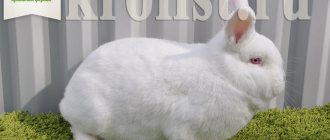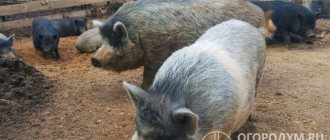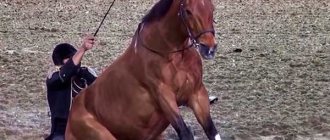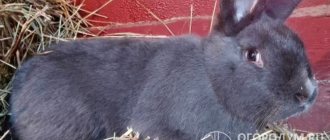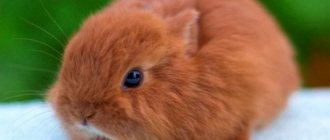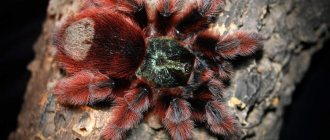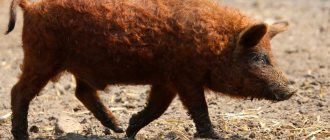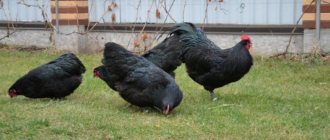Dwarf rabbit Hermelin, Polish, Ermine - this is all the name of one breed of miniature animals. These eared dogs are popular among breeders. In addition to the fact that they live well under the same roof with humans, animals of this type most often become prize-winners of international exhibitions. Breeders note that it is Polish rabbits that are the founders of most decorative species of eared animals.
History of the breed and varieties
Not much is known about the exact origin of this breed of decorative rabbits.
Hermelin - this word has Czech roots. Nevertheless, the animal is often called the Polish rabbit, perhaps because it was through this country that the variety became most widespread throughout the world.
Today rabbit breeders know about two varieties of Hermelins:
- red-eyed;
- blue-eyed.
As the name of the types suggests, they differ only in eye color. It is believed that the Hermelin red-eyed Pool Roodoog was obtained as a result of breeding work carried out by the British in the early years of the last century. The hybridization most likely involved wild, albino Angora, silver and Dutch rabbits.
Pool Blauwoog or Hermelin with blue eyes arose a little later in Germany, in 1919.
Long breeding work has continued throughout the last century, and now Hermelin is one of the most outstanding ornamental species due to its miniature size and pure white fur, which is why it is often called the ermine rabbit.
Russian rabbit breeders discovered this breed only at the very end of the last century - at an international rabbit exhibition in the capital.
Photo gallery of the Hermelin rabbit breed:
conclusions
- Rabbits of the Hermelin breed are dwarf species and are often used as ornamental animals, so they are practically not suitable for obtaining meat or fur.
- Keeping decorative breeds at home is not difficult , but these animals are picky about food and extraneous noise.
- You can breed and keep rabbits for home care , participation in exhibitions and sale.
- Hermelin rabbits are not capricious , friendly and sociable, which is why they have become widespread throughout the world.
Mr. Tail recommends: description and standard
The international standard gives the following characteristics and description of the breed:
- Head. Large, massive, with a wide forehead (5-5.5 cm). Slightly extended forward, with a touching expression on her muzzle.
- Eyes. Very large and expressive, slightly convex, widely spaced. Color - blue or red.
- Neck. It's practically non-existent, very short.
- Ears. Maximum length 5-5.5 cm. Set close to each other, short, neat, erect.
- Body. Compact, tightly knit, strong, in the shape of a small cylinder. Females have a well-developed dewlap. The croup is large, rounded with a tight-fitting short tail. Bust circumference from 20 to 25 cm.
- Paws. The front ones are very short, and the rear ones are long and strong.
- Fur. Slightly longer than short, soft and shiny.
- Color. Only ermine, snow-white. Any other shade or spots are a condition for rejection. Skin and claws are white, colorless.
- Weight. From 800 to 1500 g, average parameter 1-1.1 kg. Body weight below 800 g is considered culling for breeding.
- Fertility. Not tall. The maximum number of cubs in a litter is 5-6.
For many years, rabbit breeders have been trying to produce super-dwarf Hermelins. But the decrease in weight below 750 g led to the fact that the female rabbits practically stopped producing offspring, and if rabbits were born, there were no more than two of them in the litter.
What to feed rabbits
The digestive characteristics of rabbits require frequent consumption of food. The fact is that everything that enters the stomach is layered, each subsequent layer of food moves the lower one into the intestines. Therefore, your pet should always have something edible. Also keep an eye on the drinking bowls; the water should always be clean and fresh. It is better to fill the drinking bowl with settled or filtered water.
- carrots - carotene, retinol, almost the entire vitamin B group, iodine, fluorine (250 g per day);
- cabbage - fiber, folic and ascorbic acid, vitamin K, potassium, magnesium, calcium (270 g);
- beets (fodder or sugar) - vitamins A, B9, C, fiber, phosphorus, sulfur, chlorine (250 g);
- celery, spinach, lettuce - vitamin C, B, K, E, lutein (up to 500 g per day);
- apples - iron, copper, vitamins A, C, choline (70 g);
- branches of fruit trees and shrubs - for grinding down teeth (should always be available);
- meadow grass - up to 500 g per day.
Vitamins and minerals obtained from succulent feed support the immune system, and besides it, all systems and internal organs of the body. The deficiency immediately affects the pet’s appearance: dull fur, lethargy, peeling skin, and then on health.
Be sure to check that the packaging is sealed and expiration date, after opening, there are no foreign odors or mold.
- table (red) beets;
- red cabbage;
- porridge;
- nuts;
- dried fruits;
- food from the table (flour, sweet, smoked and salty).
Character
Hermelins are ideal for keeping at home, as their disposition is gentle and peaceful. They usually sleep peacefully during the day and it is better not to disturb them during rest.
In the evening hours, they will happily take a walk with one of their household members in the park or in the country. Therefore, it is recommended to accustom them to a harness and leash from a young age.
They also behave peacefully when walking around the house, but you should keep an eye on them so that they do not chew furniture, electrical wiring and injure themselves.
Hermelin is perfect for both single people and large families. They happily go into a person's arms, run after toys, and do not offend children.
They are smart enough to remember their name and simple commands. But at the same time, they are very stubborn and willful, so when working with them, you need to be patient.
Owner reviews
Hermelins are very beautiful and clean, and also have a fairly high intelligence and are able to become strongly attached to the owner, being wary of strangers. Such a very charming pet is able to quickly win over everyone around him, but has a fairly firm and slightly stubborn character.
Often, hermelines grow very unevenly at first - such a pet’s face and ears stretch out. The average period of such “ugly utism”, as a rule, lasts up to six months, and the full formation of a decorative rabbit ends, most often by one year.
All rabbits, by their nature, are territorial animals, so in the wild, each individual has its own, individual burrow. However, decorative rabbits quite willingly communicate with their brothers if there is a neutral territory.
This is interesting! At home, you can get a couple of dwarf rabbits and try to make them friends. A minimum of aggression is observed if animals are kept together from a very early age.
Hermelin is distinguished by fairly good health, and proper feeding and regular walks outside the cage, as well as annual vaccinations, allow such a pet to live in a home environment for ten or more years.
It should be noted that in recent years, fewer and fewer purebred Hermelins have been bred in nurseries and clubs. Many breeders prefer to keep such decorative rabbits only as improvers for certain dwarf breeds.
Care and maintenance
In order for the decorative Hermelin to live a long and happy life, he needs to create adequate conditions of detention:
- Provide a fairly spacious cage with dimensions of at least 50x40x50 cm for the baby who will be brought into the house. And at least twice as much for an adult.
- The material of the cage should be galvanized metal, since rabbits love to chew everything they can get their teeth on.
- The cage should include a small house in which the pet can hide for sleep and rest during the daytime, made of wood or plywood.
- The cage should have a tray for collecting debris and waste. It must be cleaned and disinfected at least once every 2-3 days to prevent an unpleasant odor, or better yet, daily.
- If there is no tray in the cage, then there should be a dense and fairly thick bedding - hay, which also needs to be shaken daily and changed as needed.
- It is advisable to provide a small litter tray in the cage, and teach Hermelin to use it from a young age. It is better to choose wood chip pellets as a filler.
- The pet's home should be located in such a way that there are no heating devices nearby, and the cage should not be exposed to direct sunlight. It is also necessary to ensure that there are no drafts.
- Domestic decorative rabbits drink much less than farmed breeds, but the water in the cage should always be of high quality and clean.
- It is better to install a nipple or vacuum drinking bowl for Hermelin so that the cage is always dry. The feeder is preferably of a bunker type.
- Rabbits' teeth, even such miniature ones, grow throughout their lives. Rough feed helps grind them down. For example, high-quality hay should be freely available to your pet at all times. But in addition, the animal always needs a special mineral stone in its home. The baby not only grinds his teeth on it, but also receives a lot of useful elements from this substance.
- Hermelin is a very active and mobile creature; it must be released from its cage daily. It is advisable to let him run around the apartment for at least an hour or two under strict supervision. And in the summer it would be nice to take your pet for a walk outside.
- You should pick up your baby more often, but in no case by the ears. I pick up the rabbit by the scruff of the neck, supporting it with the other hand by the hind legs and belly.
- You should brush your pet weekly, and during shedding, this should be done even more often.
- Claws need to be shortened monthly.
- Under no circumstances should you wash your rabbit. They take great care of their hygiene on their own. Bathing will do them nothing but harm.
How to care
To maintain body tone, let your rabbit out of the cage once a day. It is best to do this in the morning, when the ears are most active. Your apartment will become a walking area for them. Protect your rabbit from possible injuries by removing all dangerous substances, objects and electrical wires from its path. Protect him from other animals.
Stick to comfortable living space standards: for one rabbit this is a home of approximately 0.7x0.7 square meters. m. In the cage you need to arrange three zones - a kitchen, a bedroom and a toilet.
Ermine rabbits are easily litter trained. It is more convenient to purchase a special drinking bowl and feeder for rodents. In the house, also place items for grinding teeth - twigs, tree bark.
Proper nutrition Hermelina
Usually, Hermelin babies are purchased at the age of 2-3 months. Initially, you should provide them with a diet rich in calcium. To do this, it is advisable to include milk in the diet, preferably goat milk. But after six months you should abandon it completely.
Occasionally, your pet needs vitamin supplements, which can be purchased at a veterinary pharmacy or pet salon.
Raw vegetables and fruits should be included in the diet of adults, but not daily, but in limited quantities.
The most rational daily feeding is high-quality hay, fresh grass and mixed feed, grains. You can make hay yourself in the summer or purchase it at a pet store. This product must be in the cage at all times.
In the summer, fresh grass is cut in parks and forest clearings. Before giving it to your pet, the herbs are slightly dried and withered so as not to cause flatulence.
It is recommended to include mainly dandelion, coltsfoot, and plantain leaves in your diet. Care should be taken to ensure that poisonous species (buttercups, celandine, belladonna) do not get into the food.
You should never give an adult rabbit meat and dairy products, sweets, bread, cereals, canned food, salty, spicy, fatty, smoked and pickled foods.
Their gastrointestinal tract has a special structure and responds very quickly to changes in diet. Therefore, any new product should be introduced gradually, in small portions.
In addition to grasses and hay, the basis of nutrition should be grain crops (wheat, rye, oats) and boiled vegetables (potatoes, pumpkin). Raw fruits are given rarely, in small portions, cut up.
In winter, once or twice a week you can offer your pet a few raisins, sunflower and pumpkin seeds.
Branch food is also necessary in the nutrition of decorative rabbits, but in limited quantities. Only permitted bark and branches can be given (rowan, coniferous, maple), avoiding those whose fruits contain seeds.
Feeding
The diet of dwarf decorative rabbits should be carefully monitored. Their diet should be balanced and include in the right quantities:
- concentrates;
- roughage;
- succulent food;
- green food
Rabbit and apple
Hay should definitely be included in your pet’s menu. Compound feed designed specifically for rabbits contains everything that an eared rabbit needs every day: vitamins, microelements, organic acids, protein and other components.
Germelin's rabbits need to be given grass in the summer, but not fresh, but slightly withered. Vegetables are also included in the menu: potatoes, carrots, fodder beets, Jerusalem artichoke. From fruits, you can treat your pet to a small piece of apple, banana, or pear. However, you cannot give them in large quantities: the intestines of decorative rabbits are capricious and weak, and if the feeding rules are violated, the reaction will be instantaneous.
You cannot feed a decorative rabbit:
- cookies;
- baked goods;
- sweets;
- red beets;
- chips and snacks;
- wet and freshly cut grass, etc.
Reference. It is worth getting detailed advice from a veterinarian regarding the nutrition of the Hermelin rabbit.
Breeding
Sexual maturity occurs in some individuals as early as 6 months, but usually a little later - at 8-9.
Male and female specimens with sufficient body weight from 1.1 to 1.3 kg are allowed for breeding. This is necessary to prevent dwarfism and overgrowth from progressing.
Usually, Hermelin rabbits have about 3 rabbits in their litter, sometimes 5-6.
For mating, two healthy, vaccinated individuals are mated in the male’s territory. It can be repeated again after 5-7 days. Of course, you can keep the male and female specimens together for the whole week, but then the exact birth date will be unknown. In addition, the male is often aggressive during mating games and can injure the female rabbit.
After 28-30 days the due date arrives. The female begins to prepare for them in advance, builds a nest, plucks down from the breast and abdomen, and drags straw into the house.
At the first birth, the female rabbit may become confused and scatter the babies around the cage. They should be carefully, with clean, odorless hands (it’s better to first rub them with their mother’s down) into the house and covered with pieces of fur. Babies are born naked and with their eyes closed. Usually these measures help, and the mother immediately begins to feed the rabbits and carefully care for them.
From about 1-1.5 months, rabbits are already able to receive additional complementary foods.
Health
The Hermelin breed was obtained through crossbreeding, which is often inbreeding in nature. Not even every mating produces a result, which is generally unusual for lagomorphs. And Gremlins’ health is very fragile, they do not have strong immunity.
In addition, they have one significant drawback - excessive molting. In order to prevent your pet's gastrointestinal tract from becoming clogged with hairballs, it should be combed frequently and special pastes for hairballs should be periodically introduced into the diet.
To exclude invasive diseases, rabbits are dewormed already at 2.5-3 weeks. After 10 days they must be dewormed again.
At 28 days, mandatory vaccinations begin - the first vaccination against myxomatosis and VGCH is given, at 60 days - against rabies. At 105 days, revaccination is carried out. Then all vaccinations are repeated every six months.
With good care and proper nutrition, Hermelin can live in a family for up to 10-11 years. But you need to be attentive to your pet and remember that even vaccination does not always guarantee one hundred percent protection against infections.
The best way to maintain the health of this sweet and beautiful ermine baby is to comply with sanitary and hygienic standards, a nutritious diet and a timely visit to the veterinary clinic.
Indeed, in addition to viral pathologies, you can encounter diseases such as:
- Heat and sunstroke. Hermelins have a weak heart, and they tolerate overheating very poorly. It should be remembered that the easiest way to “cool down” your pet is by applying a cloth moistened with cool water to the ears.
- Injuries. It is very easy for these fragile babies to get dislocations, bruises and sprains; you should be very careful with them. At the slightest hint of injury, you should immediately contact a veterinarian.
- Dyspeptic phenomena. They most often occur as a result of poor diet. But sometimes, subject to vaccination against major diseases, they can be caused by coccidia. You should immediately take the baby to a veterinary clinic and begin treatment.
- Rhinitis, acute respiratory infections, pneumonia. If they are not infectious in nature, then they are a consequence of hypothermia, colds, or the animal being in a draft.
- Conjunctivitis. If this is not an infection, then, most likely, they were caused by foreign bodies that got into the pet’s eyes and caused redness, tearing, and swelling of the eyelids.
Possible diseases
Decorative ermine rabbits are susceptible to various pathologies. Among them:
- gastrointestinal diseases;
- hyperthermic shock (due to overheating);
- injuries;
- ENT pathologies;
- pododermatitis;
- conjunctivitis;
- rickets;
- frostbite;
- contagious runny nose;
- microsporia;
- VGBK;
- myxomatosis;
- staphylococcosis;
- pasteurellosis;
- listeriosis.
In addition to the above pathologies, rabbits may have genetic breed mutations, which are manifested by color defects and atypical appearance of the ears.
| Contents of the Hermelins | |
| pros | Minuses |
| Silence Flexibility to training Possibility of litter box training Economical nutrition No need for personal walking Friendly character Developed maternal instinct | Require attention and communication Males mark territory Scatter food near the cage Frequent molting Specific smell in the place where they are kept Chew furniture and wires when walking around the house Frequently get sick |
Video Rose, baby rabbit of the Hermelin breed
Acquisition
In order to purchase a purebred Hermelin, you should contact large nurseries or private breeders with a high reputation. First of all, you need to look at the parents' passports and registration cards. It is advisable not to purchase babies born as a result of inbreeding.
You should pay close attention to the appearance of the little rabbit. The eyes look shiny, clear, the coat is clean, smooth, and lush in the light. The area under the tail must be clean; discharge from the nose and eyes is unacceptable.
Hermelin's purebredness is very easy to establish - it has snow-white wool; White skin; short, narrowly set and neat, erect ears; transparent claws; red or blue eyes.
A good baby Germelina breed or show class can be purchased for a price of 5-6 thousand rubles.
What to look for when buying a rabbit
It is difficult to distinguish between a dwarf rabbit and a regular one at a young age, since all rabbits are small in size. You need to buy an animal from a nursery and do not hesitate to ask to see documents and the parent couple.
The distinctive features of Hermelin are:
- snow-white wool. There should be no stains or yellowing;
- the ears are only erect, the tips of the ears are not sharp, but softly rounded;
- the muzzle is also rounded, not sharp;
- the hind legs are stronger and longer than the front ones;
- small tail.
When purchasing, you should also make sure that the animal is healthy. Signs of a healthy individual:
- clean, discharge-free eyes;
- activity and curiosity;
- clean ears;
- shiny and thick fur without receding hairline;
- smooth breathing without wheezing or rolling.
